Analysis of Leadership Models in Healthcare and Health Promotion
VerifiedAdded on 2023/01/19
|9
|2527
|89
Essay
AI Summary
This essay delves into the critical role of leadership in healthcare, focusing on various models and their applications. It begins by emphasizing the importance of leadership skills for healthcare professionals, particularly in managerial positions and for newly qualified practitioners. The essay defines key concepts like leadership and change leadership, setting the stage for a detailed analysis of specific models. It explores authentic leadership, examining its constructs such as relational transparency and self-awareness, along with its strengths and weaknesses. The situational leadership model is also analyzed, discussing its adaptability and limitations. Furthermore, the essay covers organizational change models, including Lewin's change management model and the McKinsey 7S model, highlighting their structures, advantages, and disadvantages. The discussion extends to the significance of leadership in community health, emphasizing its role in improving health outcomes and the impact of leadership on the quality and safety of healthcare services. The essay concludes by summarizing the importance of good leadership in healthcare, and mentions other applicable leadership models.
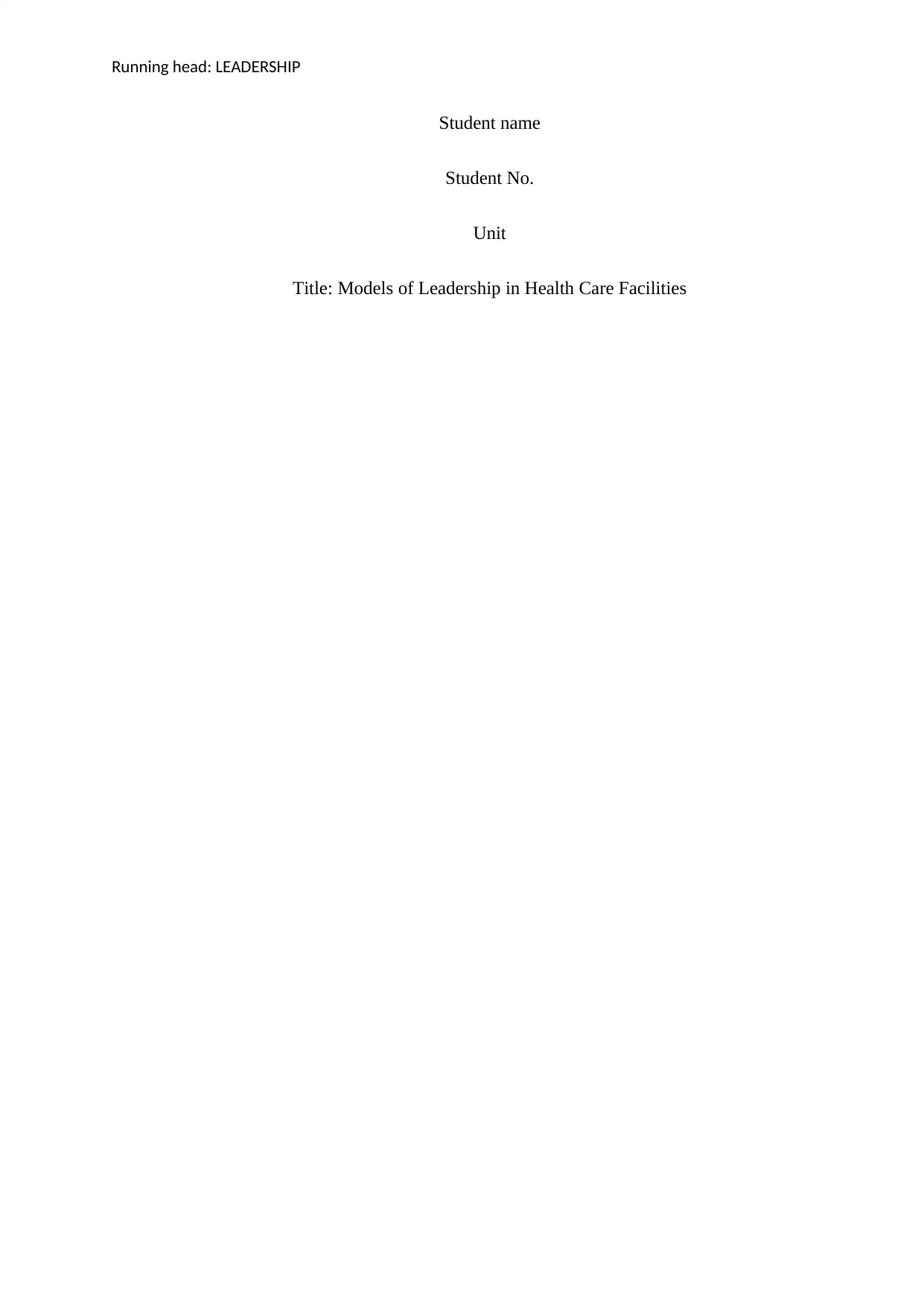
Running head: LEADERSHIP
Student name
Student No.
Unit
Title: Models of Leadership in Health Care Facilities
Student name
Student No.
Unit
Title: Models of Leadership in Health Care Facilities
Paraphrase This Document
Need a fresh take? Get an instant paraphrase of this document with our AI Paraphraser
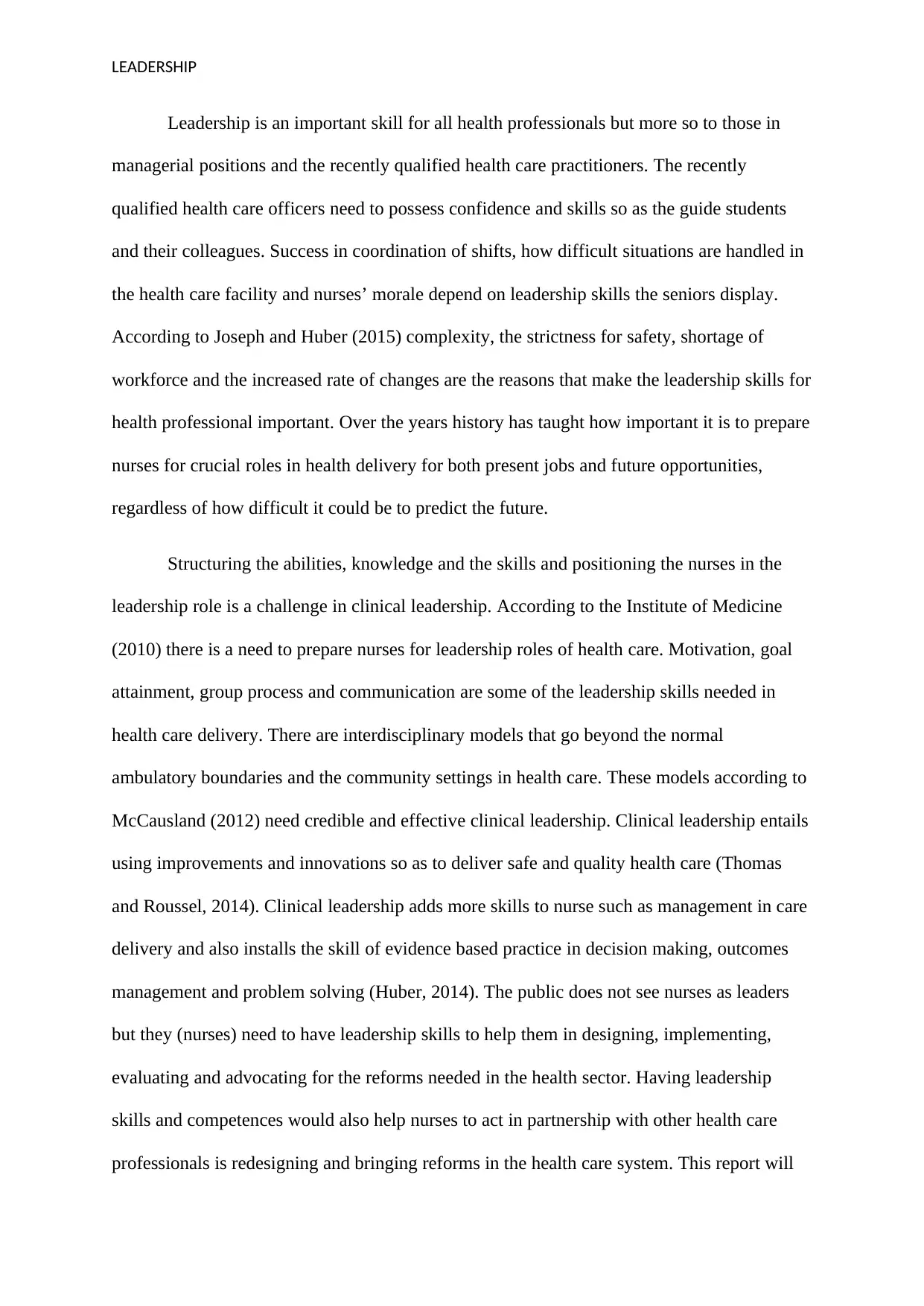
LEADERSHIP
Leadership is an important skill for all health professionals but more so to those in
managerial positions and the recently qualified health care practitioners. The recently
qualified health care officers need to possess confidence and skills so as the guide students
and their colleagues. Success in coordination of shifts, how difficult situations are handled in
the health care facility and nurses’ morale depend on leadership skills the seniors display.
According to Joseph and Huber (2015) complexity, the strictness for safety, shortage of
workforce and the increased rate of changes are the reasons that make the leadership skills for
health professional important. Over the years history has taught how important it is to prepare
nurses for crucial roles in health delivery for both present jobs and future opportunities,
regardless of how difficult it could be to predict the future.
Structuring the abilities, knowledge and the skills and positioning the nurses in the
leadership role is a challenge in clinical leadership. According to the Institute of Medicine
(2010) there is a need to prepare nurses for leadership roles of health care. Motivation, goal
attainment, group process and communication are some of the leadership skills needed in
health care delivery. There are interdisciplinary models that go beyond the normal
ambulatory boundaries and the community settings in health care. These models according to
McCausland (2012) need credible and effective clinical leadership. Clinical leadership entails
using improvements and innovations so as to deliver safe and quality health care (Thomas
and Roussel, 2014). Clinical leadership adds more skills to nurse such as management in care
delivery and also installs the skill of evidence based practice in decision making, outcomes
management and problem solving (Huber, 2014). The public does not see nurses as leaders
but they (nurses) need to have leadership skills to help them in designing, implementing,
evaluating and advocating for the reforms needed in the health sector. Having leadership
skills and competences would also help nurses to act in partnership with other health care
professionals is redesigning and bringing reforms in the health care system. This report will
Leadership is an important skill for all health professionals but more so to those in
managerial positions and the recently qualified health care practitioners. The recently
qualified health care officers need to possess confidence and skills so as the guide students
and their colleagues. Success in coordination of shifts, how difficult situations are handled in
the health care facility and nurses’ morale depend on leadership skills the seniors display.
According to Joseph and Huber (2015) complexity, the strictness for safety, shortage of
workforce and the increased rate of changes are the reasons that make the leadership skills for
health professional important. Over the years history has taught how important it is to prepare
nurses for crucial roles in health delivery for both present jobs and future opportunities,
regardless of how difficult it could be to predict the future.
Structuring the abilities, knowledge and the skills and positioning the nurses in the
leadership role is a challenge in clinical leadership. According to the Institute of Medicine
(2010) there is a need to prepare nurses for leadership roles of health care. Motivation, goal
attainment, group process and communication are some of the leadership skills needed in
health care delivery. There are interdisciplinary models that go beyond the normal
ambulatory boundaries and the community settings in health care. These models according to
McCausland (2012) need credible and effective clinical leadership. Clinical leadership entails
using improvements and innovations so as to deliver safe and quality health care (Thomas
and Roussel, 2014). Clinical leadership adds more skills to nurse such as management in care
delivery and also installs the skill of evidence based practice in decision making, outcomes
management and problem solving (Huber, 2014). The public does not see nurses as leaders
but they (nurses) need to have leadership skills to help them in designing, implementing,
evaluating and advocating for the reforms needed in the health sector. Having leadership
skills and competences would also help nurses to act in partnership with other health care
professionals is redesigning and bringing reforms in the health care system. This report will
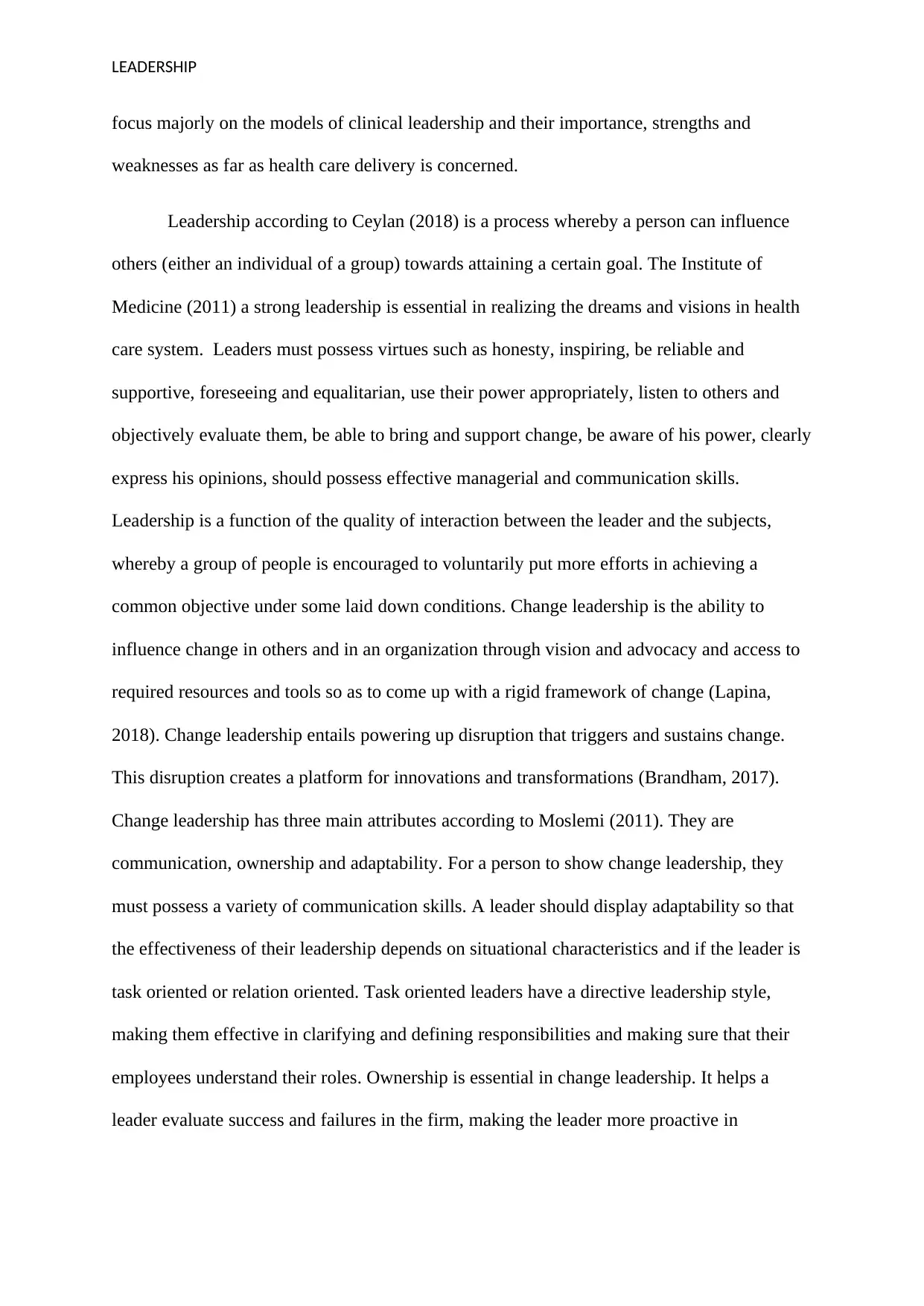
LEADERSHIP
focus majorly on the models of clinical leadership and their importance, strengths and
weaknesses as far as health care delivery is concerned.
Leadership according to Ceylan (2018) is a process whereby a person can influence
others (either an individual of a group) towards attaining a certain goal. The Institute of
Medicine (2011) a strong leadership is essential in realizing the dreams and visions in health
care system. Leaders must possess virtues such as honesty, inspiring, be reliable and
supportive, foreseeing and equalitarian, use their power appropriately, listen to others and
objectively evaluate them, be able to bring and support change, be aware of his power, clearly
express his opinions, should possess effective managerial and communication skills.
Leadership is a function of the quality of interaction between the leader and the subjects,
whereby a group of people is encouraged to voluntarily put more efforts in achieving a
common objective under some laid down conditions. Change leadership is the ability to
influence change in others and in an organization through vision and advocacy and access to
required resources and tools so as to come up with a rigid framework of change (Lapina,
2018). Change leadership entails powering up disruption that triggers and sustains change.
This disruption creates a platform for innovations and transformations (Brandham, 2017).
Change leadership has three main attributes according to Moslemi (2011). They are
communication, ownership and adaptability. For a person to show change leadership, they
must possess a variety of communication skills. A leader should display adaptability so that
the effectiveness of their leadership depends on situational characteristics and if the leader is
task oriented or relation oriented. Task oriented leaders have a directive leadership style,
making them effective in clarifying and defining responsibilities and making sure that their
employees understand their roles. Ownership is essential in change leadership. It helps a
leader evaluate success and failures in the firm, making the leader more proactive in
focus majorly on the models of clinical leadership and their importance, strengths and
weaknesses as far as health care delivery is concerned.
Leadership according to Ceylan (2018) is a process whereby a person can influence
others (either an individual of a group) towards attaining a certain goal. The Institute of
Medicine (2011) a strong leadership is essential in realizing the dreams and visions in health
care system. Leaders must possess virtues such as honesty, inspiring, be reliable and
supportive, foreseeing and equalitarian, use their power appropriately, listen to others and
objectively evaluate them, be able to bring and support change, be aware of his power, clearly
express his opinions, should possess effective managerial and communication skills.
Leadership is a function of the quality of interaction between the leader and the subjects,
whereby a group of people is encouraged to voluntarily put more efforts in achieving a
common objective under some laid down conditions. Change leadership is the ability to
influence change in others and in an organization through vision and advocacy and access to
required resources and tools so as to come up with a rigid framework of change (Lapina,
2018). Change leadership entails powering up disruption that triggers and sustains change.
This disruption creates a platform for innovations and transformations (Brandham, 2017).
Change leadership has three main attributes according to Moslemi (2011). They are
communication, ownership and adaptability. For a person to show change leadership, they
must possess a variety of communication skills. A leader should display adaptability so that
the effectiveness of their leadership depends on situational characteristics and if the leader is
task oriented or relation oriented. Task oriented leaders have a directive leadership style,
making them effective in clarifying and defining responsibilities and making sure that their
employees understand their roles. Ownership is essential in change leadership. It helps a
leader evaluate success and failures in the firm, making the leader more proactive in
⊘ This is a preview!⊘
Do you want full access?
Subscribe today to unlock all pages.

Trusted by 1+ million students worldwide
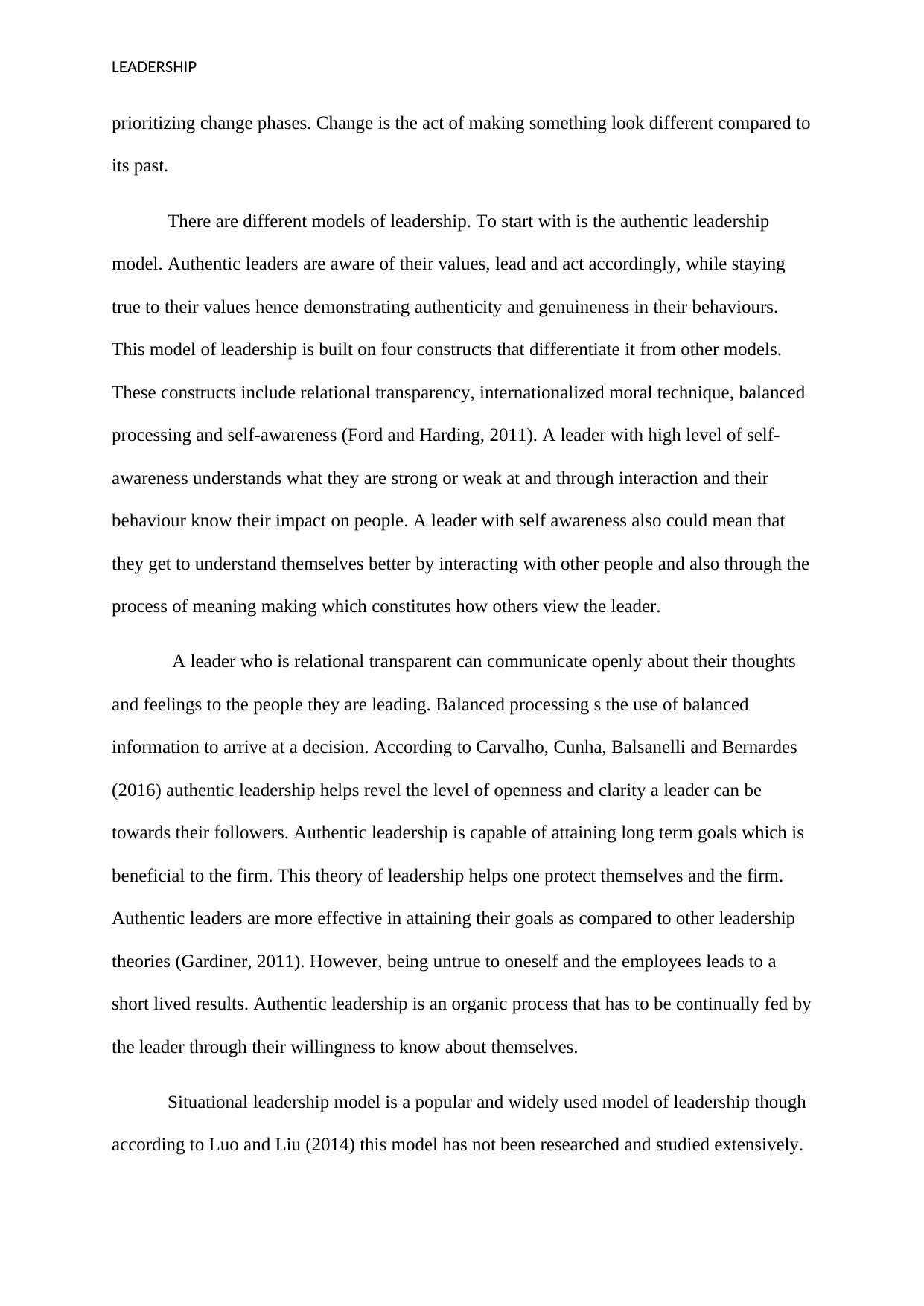
LEADERSHIP
prioritizing change phases. Change is the act of making something look different compared to
its past.
There are different models of leadership. To start with is the authentic leadership
model. Authentic leaders are aware of their values, lead and act accordingly, while staying
true to their values hence demonstrating authenticity and genuineness in their behaviours.
This model of leadership is built on four constructs that differentiate it from other models.
These constructs include relational transparency, internationalized moral technique, balanced
processing and self-awareness (Ford and Harding, 2011). A leader with high level of self-
awareness understands what they are strong or weak at and through interaction and their
behaviour know their impact on people. A leader with self awareness also could mean that
they get to understand themselves better by interacting with other people and also through the
process of meaning making which constitutes how others view the leader.
A leader who is relational transparent can communicate openly about their thoughts
and feelings to the people they are leading. Balanced processing s the use of balanced
information to arrive at a decision. According to Carvalho, Cunha, Balsanelli and Bernardes
(2016) authentic leadership helps revel the level of openness and clarity a leader can be
towards their followers. Authentic leadership is capable of attaining long term goals which is
beneficial to the firm. This theory of leadership helps one protect themselves and the firm.
Authentic leaders are more effective in attaining their goals as compared to other leadership
theories (Gardiner, 2011). However, being untrue to oneself and the employees leads to a
short lived results. Authentic leadership is an organic process that has to be continually fed by
the leader through their willingness to know about themselves.
Situational leadership model is a popular and widely used model of leadership though
according to Luo and Liu (2014) this model has not been researched and studied extensively.
prioritizing change phases. Change is the act of making something look different compared to
its past.
There are different models of leadership. To start with is the authentic leadership
model. Authentic leaders are aware of their values, lead and act accordingly, while staying
true to their values hence demonstrating authenticity and genuineness in their behaviours.
This model of leadership is built on four constructs that differentiate it from other models.
These constructs include relational transparency, internationalized moral technique, balanced
processing and self-awareness (Ford and Harding, 2011). A leader with high level of self-
awareness understands what they are strong or weak at and through interaction and their
behaviour know their impact on people. A leader with self awareness also could mean that
they get to understand themselves better by interacting with other people and also through the
process of meaning making which constitutes how others view the leader.
A leader who is relational transparent can communicate openly about their thoughts
and feelings to the people they are leading. Balanced processing s the use of balanced
information to arrive at a decision. According to Carvalho, Cunha, Balsanelli and Bernardes
(2016) authentic leadership helps revel the level of openness and clarity a leader can be
towards their followers. Authentic leadership is capable of attaining long term goals which is
beneficial to the firm. This theory of leadership helps one protect themselves and the firm.
Authentic leaders are more effective in attaining their goals as compared to other leadership
theories (Gardiner, 2011). However, being untrue to oneself and the employees leads to a
short lived results. Authentic leadership is an organic process that has to be continually fed by
the leader through their willingness to know about themselves.
Situational leadership model is a popular and widely used model of leadership though
according to Luo and Liu (2014) this model has not been researched and studied extensively.
Paraphrase This Document
Need a fresh take? Get an instant paraphrase of this document with our AI Paraphraser
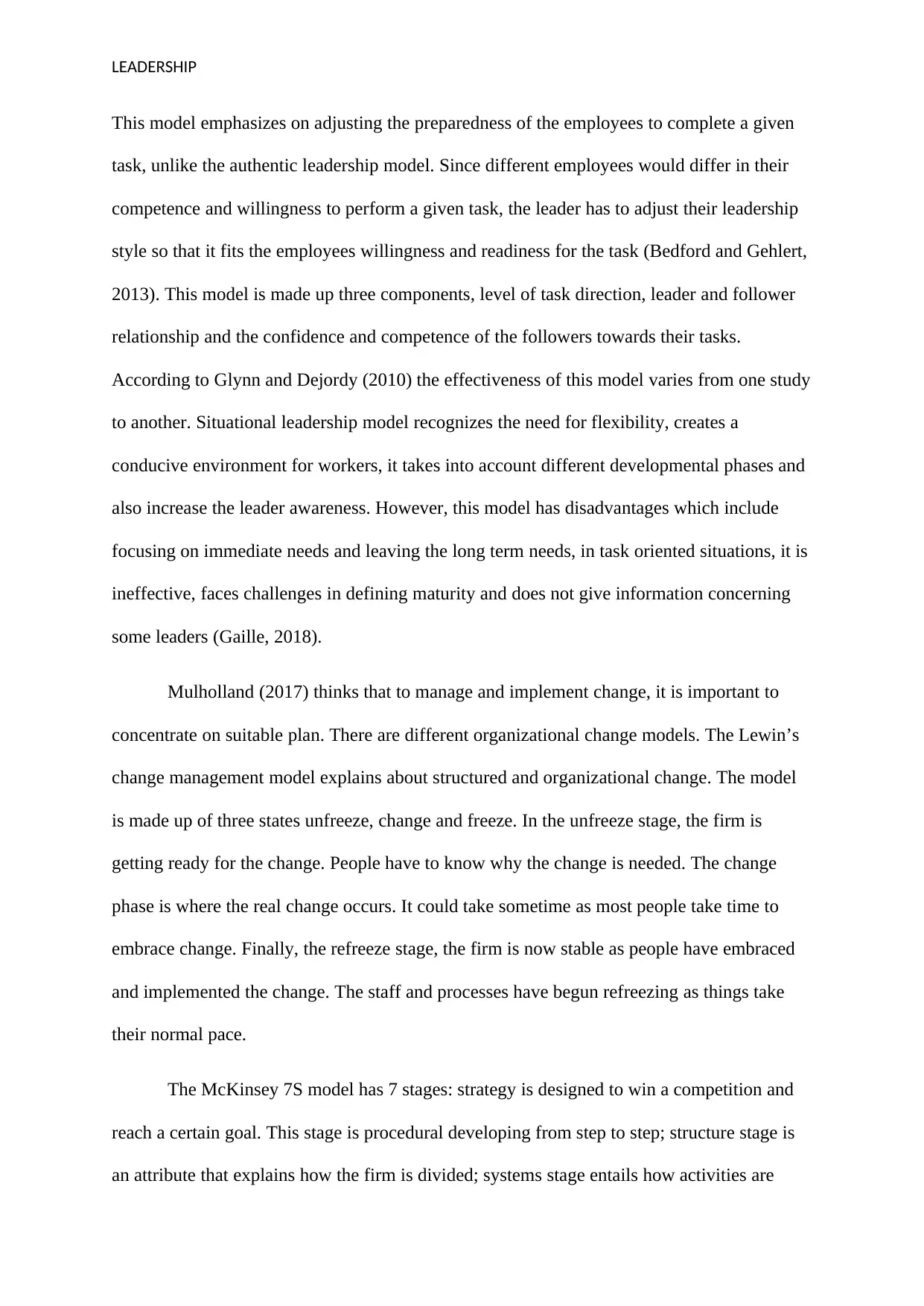
LEADERSHIP
This model emphasizes on adjusting the preparedness of the employees to complete a given
task, unlike the authentic leadership model. Since different employees would differ in their
competence and willingness to perform a given task, the leader has to adjust their leadership
style so that it fits the employees willingness and readiness for the task (Bedford and Gehlert,
2013). This model is made up three components, level of task direction, leader and follower
relationship and the confidence and competence of the followers towards their tasks.
According to Glynn and Dejordy (2010) the effectiveness of this model varies from one study
to another. Situational leadership model recognizes the need for flexibility, creates a
conducive environment for workers, it takes into account different developmental phases and
also increase the leader awareness. However, this model has disadvantages which include
focusing on immediate needs and leaving the long term needs, in task oriented situations, it is
ineffective, faces challenges in defining maturity and does not give information concerning
some leaders (Gaille, 2018).
Mulholland (2017) thinks that to manage and implement change, it is important to
concentrate on suitable plan. There are different organizational change models. The Lewin’s
change management model explains about structured and organizational change. The model
is made up of three states unfreeze, change and freeze. In the unfreeze stage, the firm is
getting ready for the change. People have to know why the change is needed. The change
phase is where the real change occurs. It could take sometime as most people take time to
embrace change. Finally, the refreeze stage, the firm is now stable as people have embraced
and implemented the change. The staff and processes have begun refreezing as things take
their normal pace.
The McKinsey 7S model has 7 stages: strategy is designed to win a competition and
reach a certain goal. This stage is procedural developing from step to step; structure stage is
an attribute that explains how the firm is divided; systems stage entails how activities are
This model emphasizes on adjusting the preparedness of the employees to complete a given
task, unlike the authentic leadership model. Since different employees would differ in their
competence and willingness to perform a given task, the leader has to adjust their leadership
style so that it fits the employees willingness and readiness for the task (Bedford and Gehlert,
2013). This model is made up three components, level of task direction, leader and follower
relationship and the confidence and competence of the followers towards their tasks.
According to Glynn and Dejordy (2010) the effectiveness of this model varies from one study
to another. Situational leadership model recognizes the need for flexibility, creates a
conducive environment for workers, it takes into account different developmental phases and
also increase the leader awareness. However, this model has disadvantages which include
focusing on immediate needs and leaving the long term needs, in task oriented situations, it is
ineffective, faces challenges in defining maturity and does not give information concerning
some leaders (Gaille, 2018).
Mulholland (2017) thinks that to manage and implement change, it is important to
concentrate on suitable plan. There are different organizational change models. The Lewin’s
change management model explains about structured and organizational change. The model
is made up of three states unfreeze, change and freeze. In the unfreeze stage, the firm is
getting ready for the change. People have to know why the change is needed. The change
phase is where the real change occurs. It could take sometime as most people take time to
embrace change. Finally, the refreeze stage, the firm is now stable as people have embraced
and implemented the change. The staff and processes have begun refreezing as things take
their normal pace.
The McKinsey 7S model has 7 stages: strategy is designed to win a competition and
reach a certain goal. This stage is procedural developing from step to step; structure stage is
an attribute that explains how the firm is divided; systems stage entails how activities are
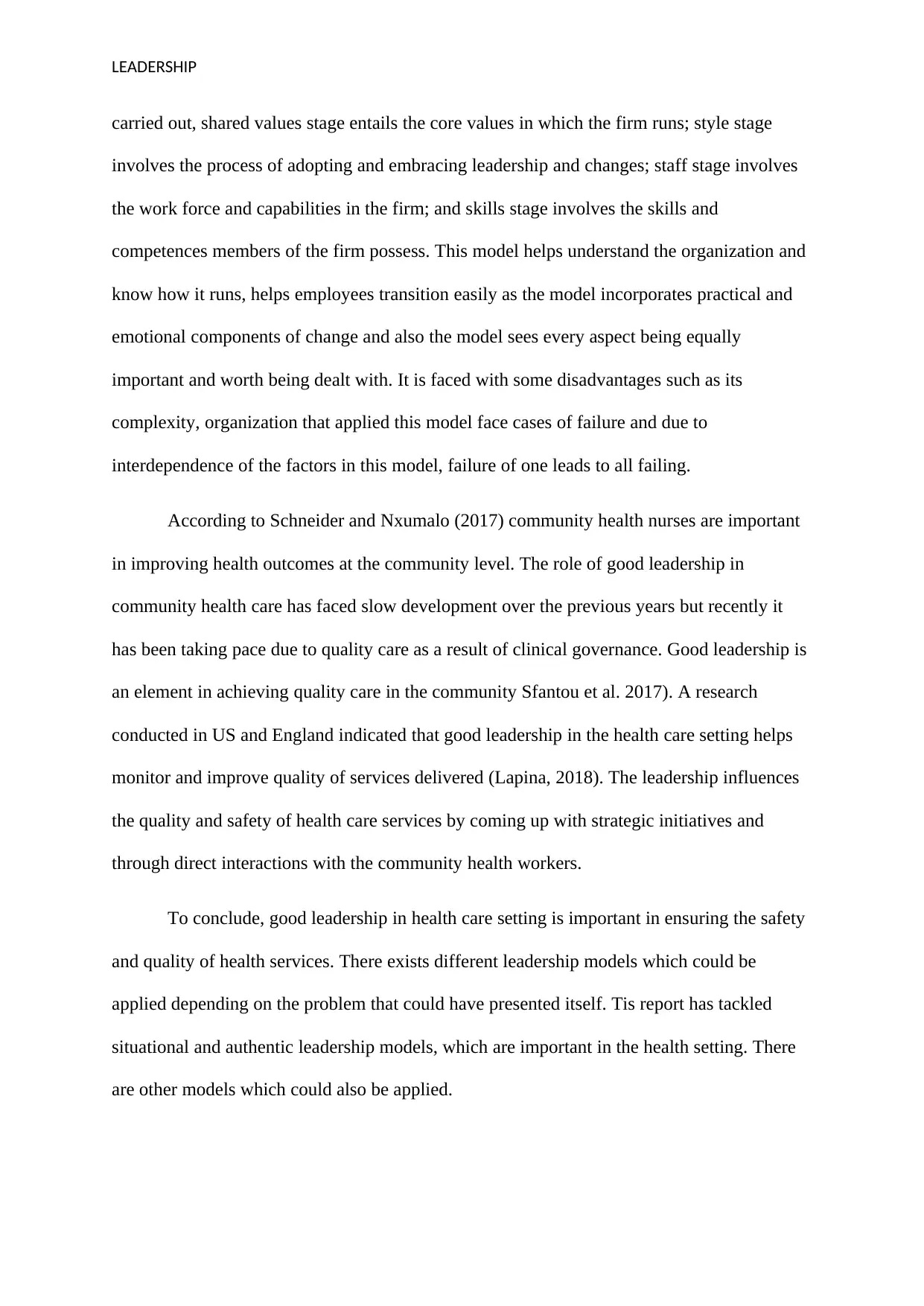
LEADERSHIP
carried out, shared values stage entails the core values in which the firm runs; style stage
involves the process of adopting and embracing leadership and changes; staff stage involves
the work force and capabilities in the firm; and skills stage involves the skills and
competences members of the firm possess. This model helps understand the organization and
know how it runs, helps employees transition easily as the model incorporates practical and
emotional components of change and also the model sees every aspect being equally
important and worth being dealt with. It is faced with some disadvantages such as its
complexity, organization that applied this model face cases of failure and due to
interdependence of the factors in this model, failure of one leads to all failing.
According to Schneider and Nxumalo (2017) community health nurses are important
in improving health outcomes at the community level. The role of good leadership in
community health care has faced slow development over the previous years but recently it
has been taking pace due to quality care as a result of clinical governance. Good leadership is
an element in achieving quality care in the community Sfantou et al. 2017). A research
conducted in US and England indicated that good leadership in the health care setting helps
monitor and improve quality of services delivered (Lapina, 2018). The leadership influences
the quality and safety of health care services by coming up with strategic initiatives and
through direct interactions with the community health workers.
To conclude, good leadership in health care setting is important in ensuring the safety
and quality of health services. There exists different leadership models which could be
applied depending on the problem that could have presented itself. Tis report has tackled
situational and authentic leadership models, which are important in the health setting. There
are other models which could also be applied.
carried out, shared values stage entails the core values in which the firm runs; style stage
involves the process of adopting and embracing leadership and changes; staff stage involves
the work force and capabilities in the firm; and skills stage involves the skills and
competences members of the firm possess. This model helps understand the organization and
know how it runs, helps employees transition easily as the model incorporates practical and
emotional components of change and also the model sees every aspect being equally
important and worth being dealt with. It is faced with some disadvantages such as its
complexity, organization that applied this model face cases of failure and due to
interdependence of the factors in this model, failure of one leads to all failing.
According to Schneider and Nxumalo (2017) community health nurses are important
in improving health outcomes at the community level. The role of good leadership in
community health care has faced slow development over the previous years but recently it
has been taking pace due to quality care as a result of clinical governance. Good leadership is
an element in achieving quality care in the community Sfantou et al. 2017). A research
conducted in US and England indicated that good leadership in the health care setting helps
monitor and improve quality of services delivered (Lapina, 2018). The leadership influences
the quality and safety of health care services by coming up with strategic initiatives and
through direct interactions with the community health workers.
To conclude, good leadership in health care setting is important in ensuring the safety
and quality of health services. There exists different leadership models which could be
applied depending on the problem that could have presented itself. Tis report has tackled
situational and authentic leadership models, which are important in the health setting. There
are other models which could also be applied.
⊘ This is a preview!⊘
Do you want full access?
Subscribe today to unlock all pages.

Trusted by 1+ million students worldwide
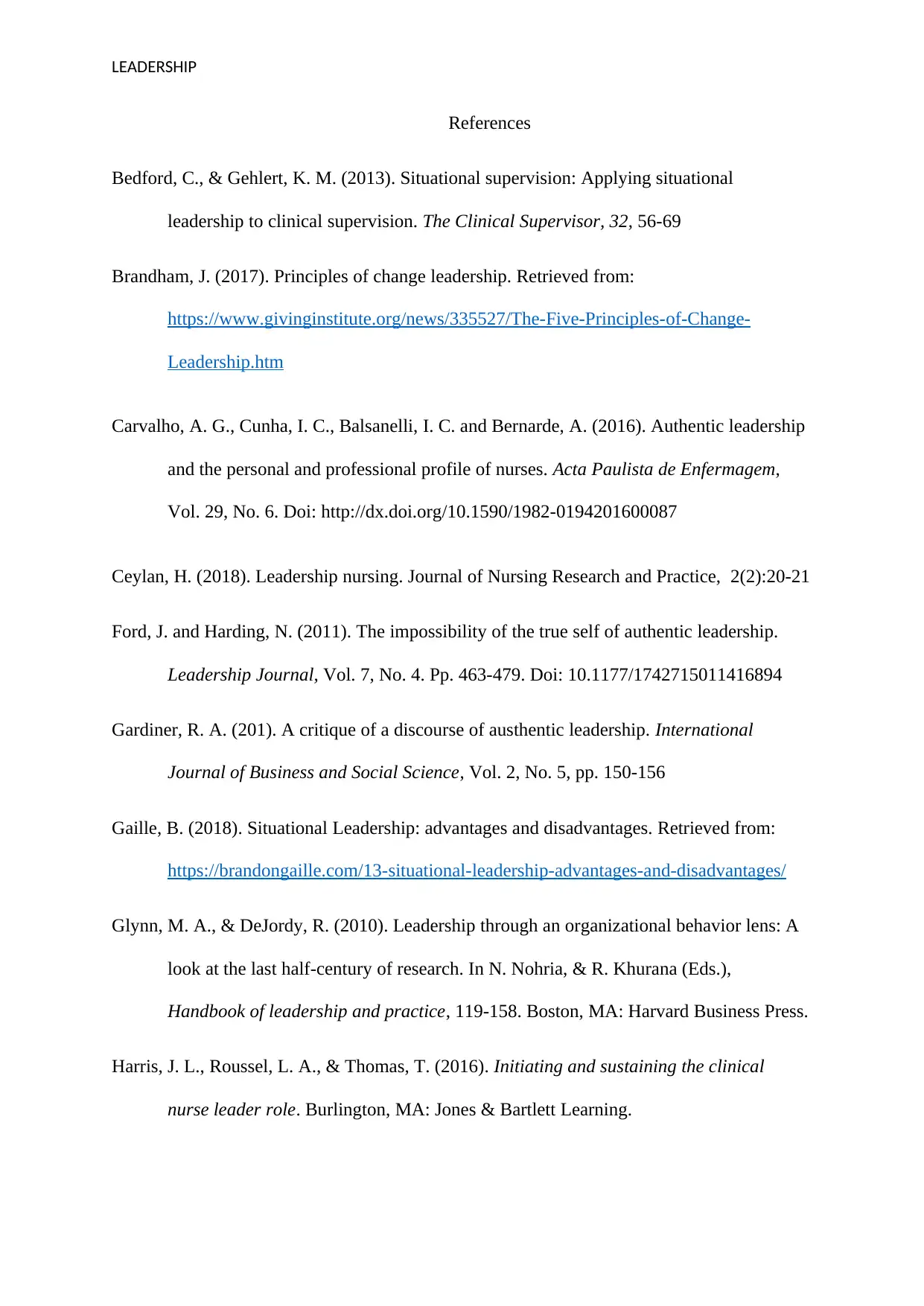
LEADERSHIP
References
Bedford, C., & Gehlert, K. M. (2013). Situational supervision: Applying situational
leadership to clinical supervision. The Clinical Supervisor, 32, 56-69
Brandham, J. (2017). Principles of change leadership. Retrieved from:
https://www.givinginstitute.org/news/335527/The-Five-Principles-of-Change-
Leadership.htm
Carvalho, A. G., Cunha, I. C., Balsanelli, I. C. and Bernarde, A. (2016). Authentic leadership
and the personal and professional profile of nurses. Acta Paulista de Enfermagem,
Vol. 29, No. 6. Doi: http://dx.doi.org/10.1590/1982-0194201600087
Ceylan, H. (2018). Leadership nursing. Journal of Nursing Research and Practice, 2(2):20-21
Ford, J. and Harding, N. (2011). The impossibility of the true self of authentic leadership.
Leadership Journal, Vol. 7, No. 4. Pp. 463-479. Doi: 10.1177/1742715011416894
Gardiner, R. A. (201). A critique of a discourse of austhentic leadership. International
Journal of Business and Social Science, Vol. 2, No. 5, pp. 150-156
Gaille, B. (2018). Situational Leadership: advantages and disadvantages. Retrieved from:
https://brandongaille.com/13-situational-leadership-advantages-and-disadvantages/
Glynn, M. A., & DeJordy, R. (2010). Leadership through an organizational behavior lens: A
look at the last half-century of research. In N. Nohria, & R. Khurana (Eds.),
Handbook of leadership and practice, 119-158. Boston, MA: Harvard Business Press.
Harris, J. L., Roussel, L. A., & Thomas, T. (2016). Initiating and sustaining the clinical
nurse leader role. Burlington, MA: Jones & Bartlett Learning.
References
Bedford, C., & Gehlert, K. M. (2013). Situational supervision: Applying situational
leadership to clinical supervision. The Clinical Supervisor, 32, 56-69
Brandham, J. (2017). Principles of change leadership. Retrieved from:
https://www.givinginstitute.org/news/335527/The-Five-Principles-of-Change-
Leadership.htm
Carvalho, A. G., Cunha, I. C., Balsanelli, I. C. and Bernarde, A. (2016). Authentic leadership
and the personal and professional profile of nurses. Acta Paulista de Enfermagem,
Vol. 29, No. 6. Doi: http://dx.doi.org/10.1590/1982-0194201600087
Ceylan, H. (2018). Leadership nursing. Journal of Nursing Research and Practice, 2(2):20-21
Ford, J. and Harding, N. (2011). The impossibility of the true self of authentic leadership.
Leadership Journal, Vol. 7, No. 4. Pp. 463-479. Doi: 10.1177/1742715011416894
Gardiner, R. A. (201). A critique of a discourse of austhentic leadership. International
Journal of Business and Social Science, Vol. 2, No. 5, pp. 150-156
Gaille, B. (2018). Situational Leadership: advantages and disadvantages. Retrieved from:
https://brandongaille.com/13-situational-leadership-advantages-and-disadvantages/
Glynn, M. A., & DeJordy, R. (2010). Leadership through an organizational behavior lens: A
look at the last half-century of research. In N. Nohria, & R. Khurana (Eds.),
Handbook of leadership and practice, 119-158. Boston, MA: Harvard Business Press.
Harris, J. L., Roussel, L. A., & Thomas, T. (2016). Initiating and sustaining the clinical
nurse leader role. Burlington, MA: Jones & Bartlett Learning.
Paraphrase This Document
Need a fresh take? Get an instant paraphrase of this document with our AI Paraphraser
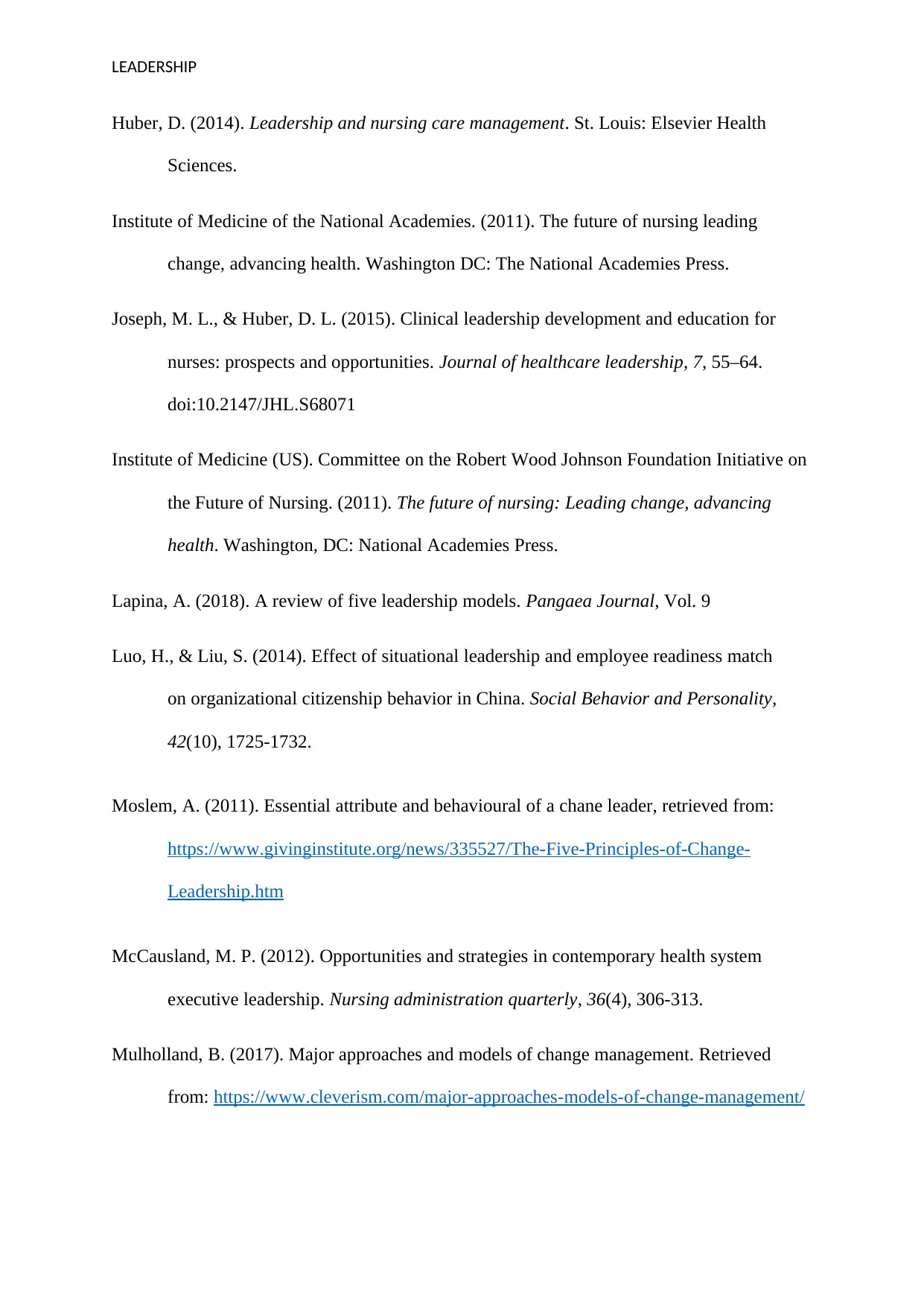
LEADERSHIP
Huber, D. (2014). Leadership and nursing care management. St. Louis: Elsevier Health
Sciences.
Institute of Medicine of the National Academies. (2011). The future of nursing leading
change, advancing health. Washington DC: The National Academies Press.
Joseph, M. L., & Huber, D. L. (2015). Clinical leadership development and education for
nurses: prospects and opportunities. Journal of healthcare leadership, 7, 55–64.
doi:10.2147/JHL.S68071
Institute of Medicine (US). Committee on the Robert Wood Johnson Foundation Initiative on
the Future of Nursing. (2011). The future of nursing: Leading change, advancing
health. Washington, DC: National Academies Press.
Lapina, A. (2018). A review of five leadership models. Pangaea Journal, Vol. 9
Luo, H., & Liu, S. (2014). Effect of situational leadership and employee readiness match
on organizational citizenship behavior in China. Social Behavior and Personality,
42(10), 1725-1732.
Moslem, A. (2011). Essential attribute and behavioural of a chane leader, retrieved from:
https://www.givinginstitute.org/news/335527/The-Five-Principles-of-Change-
Leadership.htm
McCausland, M. P. (2012). Opportunities and strategies in contemporary health system
executive leadership. Nursing administration quarterly, 36(4), 306-313.
Mulholland, B. (2017). Major approaches and models of change management. Retrieved
from: https://www.cleverism.com/major-approaches-models-of-change-management/
Huber, D. (2014). Leadership and nursing care management. St. Louis: Elsevier Health
Sciences.
Institute of Medicine of the National Academies. (2011). The future of nursing leading
change, advancing health. Washington DC: The National Academies Press.
Joseph, M. L., & Huber, D. L. (2015). Clinical leadership development and education for
nurses: prospects and opportunities. Journal of healthcare leadership, 7, 55–64.
doi:10.2147/JHL.S68071
Institute of Medicine (US). Committee on the Robert Wood Johnson Foundation Initiative on
the Future of Nursing. (2011). The future of nursing: Leading change, advancing
health. Washington, DC: National Academies Press.
Lapina, A. (2018). A review of five leadership models. Pangaea Journal, Vol. 9
Luo, H., & Liu, S. (2014). Effect of situational leadership and employee readiness match
on organizational citizenship behavior in China. Social Behavior and Personality,
42(10), 1725-1732.
Moslem, A. (2011). Essential attribute and behavioural of a chane leader, retrieved from:
https://www.givinginstitute.org/news/335527/The-Five-Principles-of-Change-
Leadership.htm
McCausland, M. P. (2012). Opportunities and strategies in contemporary health system
executive leadership. Nursing administration quarterly, 36(4), 306-313.
Mulholland, B. (2017). Major approaches and models of change management. Retrieved
from: https://www.cleverism.com/major-approaches-models-of-change-management/
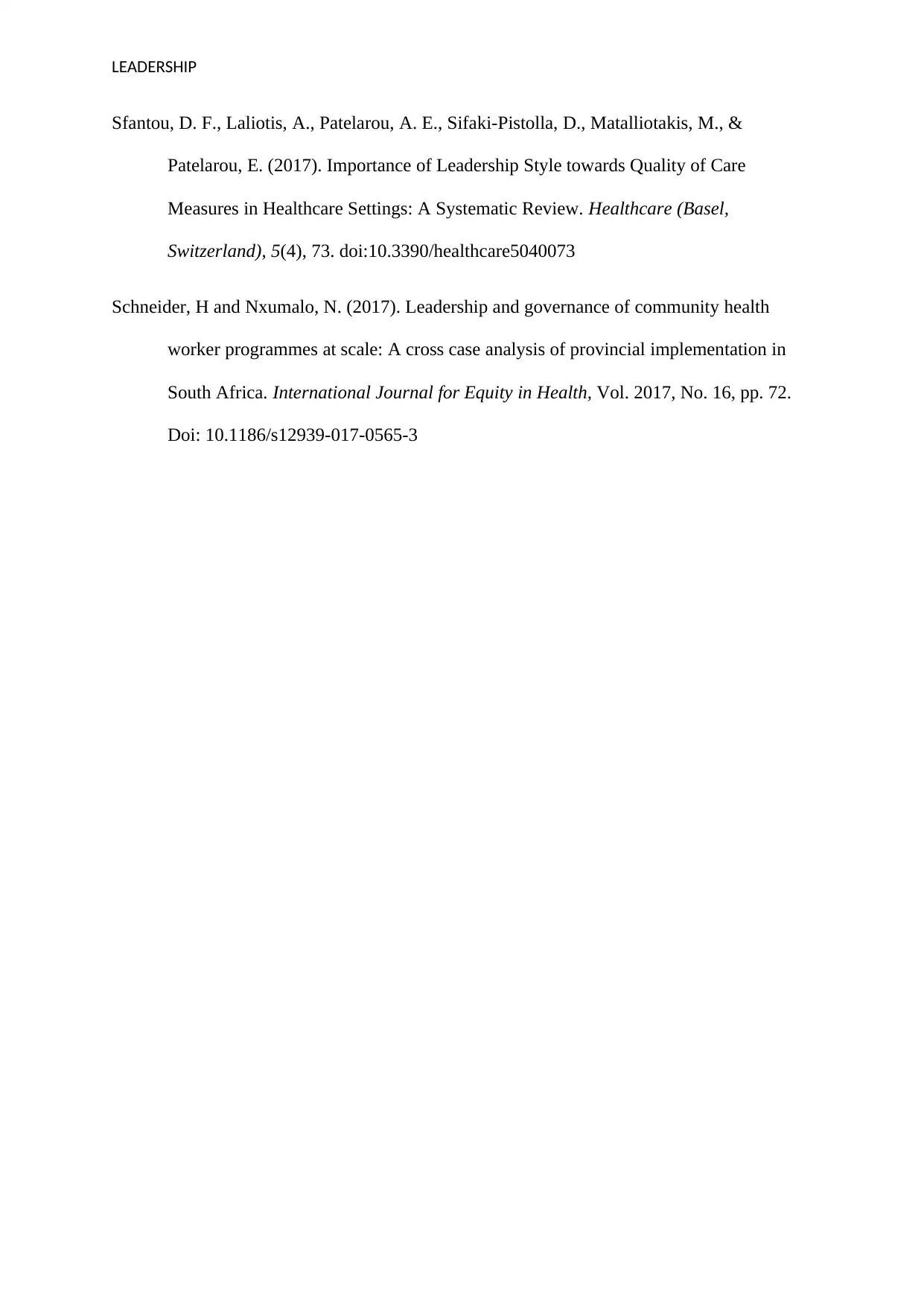
LEADERSHIP
Sfantou, D. F., Laliotis, A., Patelarou, A. E., Sifaki-Pistolla, D., Matalliotakis, M., &
Patelarou, E. (2017). Importance of Leadership Style towards Quality of Care
Measures in Healthcare Settings: A Systematic Review. Healthcare (Basel,
Switzerland), 5(4), 73. doi:10.3390/healthcare5040073
Schneider, H and Nxumalo, N. (2017). Leadership and governance of community health
worker programmes at scale: A cross case analysis of provincial implementation in
South Africa. International Journal for Equity in Health, Vol. 2017, No. 16, pp. 72.
Doi: 10.1186/s12939-017-0565-3
Sfantou, D. F., Laliotis, A., Patelarou, A. E., Sifaki-Pistolla, D., Matalliotakis, M., &
Patelarou, E. (2017). Importance of Leadership Style towards Quality of Care
Measures in Healthcare Settings: A Systematic Review. Healthcare (Basel,
Switzerland), 5(4), 73. doi:10.3390/healthcare5040073
Schneider, H and Nxumalo, N. (2017). Leadership and governance of community health
worker programmes at scale: A cross case analysis of provincial implementation in
South Africa. International Journal for Equity in Health, Vol. 2017, No. 16, pp. 72.
Doi: 10.1186/s12939-017-0565-3
⊘ This is a preview!⊘
Do you want full access?
Subscribe today to unlock all pages.

Trusted by 1+ million students worldwide
1 out of 9
Related Documents
Your All-in-One AI-Powered Toolkit for Academic Success.
+13062052269
info@desklib.com
Available 24*7 on WhatsApp / Email
![[object Object]](/_next/static/media/star-bottom.7253800d.svg)
Unlock your academic potential
Copyright © 2020–2025 A2Z Services. All Rights Reserved. Developed and managed by ZUCOL.





